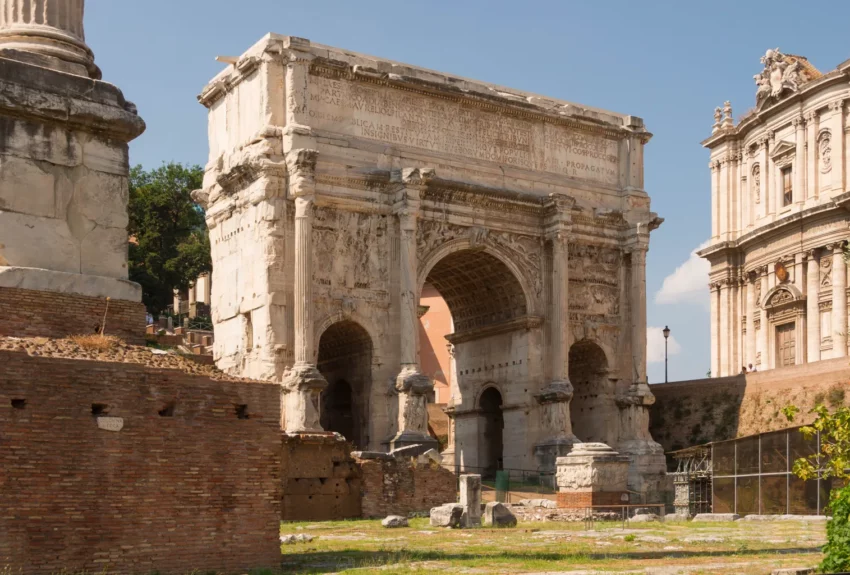The Arch of Septimius Severus is a triumphal arch located in Rome, Italy. Erected in 203 AD, it stands at the northwest end of the Roman Forum. This monument commemorates the Roman victories of Emperor Septimius Severus and his sons, Caracalla and Geta, over the Parthians. The arch is a testament to the architectural and artistic prowess of ancient Rome. It features intricate reliefs depicting scenes of battle and the emperor’s campaigns. Over time, the arch has become a symbol of the power and durability of the Roman Empire.
Get your dose of History via Email
Historical Background of the Arch of Septimius Severus
The Arch of Septimius Severus was built by the Roman Senate to honor the emperor’s victories in the East. Septimius Severus, who ruled from 193 to 211 AD, expanded the empire’s boundaries. The arch was dedicated in 203 AD, marking the tenth anniversary of Severus’ reign. It has stood for centuries as a monument to his military success.
The arch’s discovery and documentation date back to the Renaissance when antiquarians began studying Roman ruins. It was during this period that the arch was drawn and described in detail. The monument was well-preserved, owing to its continuous visibility and prominence in the Forum.
Septimius Severus, born in Leptis Magna (present-day Libya), commissioned the arch. It was likely designed by Roman architects and built by skilled artisans. The structure has survived various periods of history, including the Middle Ages when it was incorporated into a fortress.
The arch has not only been a passive witness to history but also an active participant. It has seen countless processions and events throughout Rome’s history. In the medieval era, it was part of the fortifications of the powerful Frangipani family.
Although the arch has not been the scene of any specific historical event, it represents the broader historical importance of Roman triumphs. It has also been a subject of scholarly study, contributing to our understanding of Roman art and propaganda.
About the Arch of Septimius Severus
The Arch of Septimius Severus stands 23 meters high and 25 meters wide. It is made of Proconnesian marble, a material prized for its quality and durability. The arch features three arched passageways, with the central one being the widest.
The arch’s façade is richly decorated with relief panels. These panels depict scenes from the military campaigns against the Parthians. The reliefs serve not only as art but also as a narrative of Septimius Severus’ victories.
The structure is a fine example of Roman architectural skill. It includes fluted columns, intricate capitals, and a deep entablature. The attic, the uppermost part of the arch, originally bore inscriptions honoring Septimius Severus and his sons.
Over time, the arch has undergone conservation efforts to preserve its intricate carvings and structure. These efforts ensure that the arch remains a testament to Roman engineering and artistry for future generations.
The Arch of Septimius Severus is not only a monument but also an educational resource. It provides insight into Roman construction techniques, such as the use of a wooden framework to support the arch during construction.
Theories and Interpretations
The Arch of Septimius Severus has been the subject of various theories and interpretations. Scholars have studied the reliefs to understand the historical events they depict. The scenes are rich in symbolism and have been carefully analyzed to piece together the story of Severus’ campaigns.
There is a mystery surrounding the fate of Geta, whose name and image were removed from the arch. This act of damnatio memoriae was carried out after his assassination and the rise of his brother Caracalla to power.
Historians have matched the reliefs and inscriptions on the arch with historical records. This has helped to confirm the accuracy of Roman historical accounts and provided a visual complement to written sources.
Dating of the arch has been straightforward, thanks to the inscriptions that commemorate its dedication date. The style of the reliefs also corresponds with the artistic trends of the early 3rd century AD.
The arch’s purpose as a triumphal monument is clear, but its role in the social and political life of Rome is a deeper subject of study. It has been interpreted as a tool of imperial propaganda, designed to legitimize Severus’ rule and military actions.
At a glance
Country: Italy
Civilization: Ancient Rome
Age: Erected in 203 AD
Conclusion and Sources
The Arch of Septimius Severus remains a significant historical and architectural landmark. It provides a window into the past, offering insights into the Roman Empire’s military, political, and artistic achievements. The arch’s enduring presence in the Roman Forum is a testament to the lasting legacy of Septimius Severus and the empire he ruled.
Reputable sources used in the creation of this article include:

